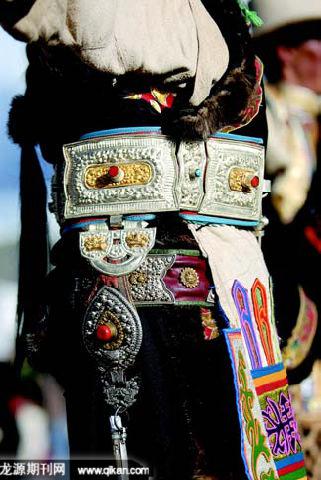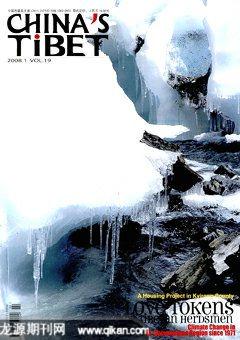Love Tokens of Tibetan Herdsmen
Ye Yuling

Tibet is a large, isolated land with a harsh climate. Previously, herdsmen lived in scattered remote areas. Although cultural activities are few, the love life of herdsmen is as colourful as a rainbow, as beautiful and as bright.
Visitors find themselves in the grassland by accident encounter wonderful scenes. The young men and girls stand on different hills or river banks singing songs in antiphonal style; a group of herdsmen riding on horses and clustering around their fiancées. They sometimes stop to drink and sing Lagzhas, folk songs of love, and then dash off into the splendid landscape.
Herdsmen usually live amongst their family and relations, and rarely interact with anyone else. Young people, if they are not living in the same grassland, dont often visit one another. The only opportunities for them to get in touch with are on special occasions, as house racing, religious activities, festivals, markets, and art performances. If a young man and a girl are acquainted with each other and become attracted, they will find an opportunity to either sing Lagzhas or make a date to meet each other.
People say, “Three sentences of Lagzhas can express all the sentiments oflove” and Lagzhas are thematchmaker.” Lagzhas is a bridge between young herdsmen and girls. The young generation relies on Lagzhas to meet and choose lovers.
Lagzhas are usually sung in an antiphonal style. There is no fixed format and people often just improvise. Therefore, the singers usually first choose a wonderful place to sing. A boy and girl appoint the place and then the boy drives yaks up one hill, while the girl isguiding sheep to the opposite hill. At a certain point they start to sing Lagzhas. Basically, they draw on their sentiments and the environment, combined with their feelings, and improvise lyrics to introduce themselves and explore each other through singing. The contents might include personality, family situation, interests, preferences,aptitudes, feelings of love and so on covering various fields related with social relationships and their lives. Having understood each other, their love is ignited, gradually burningand spreading in their hearts. Then they exchange keepsakes as evidence of their love.
Tibetan love tokens are usually quite varied. They could be personal belongings (such as clothes, hats, shoes, jewelry, tools of trade, accessories, horses and saddles and related goods, guns, broadswords, and even personal hair and nails). Generally, they take what they have to hand and pay more attention to personal belongings than precious items. Some keepsakes might be frequently used items. Therefore, for generations such items have become common love tokens for boys and girls.

Bootstrap: a symbol of love
When a boy and girl are dating, they tend to use their grazing livestock to move close to each other, face to face to sing Lagzhas. While singing, they gradually shorten the distance until they can sit down together in the meadow. Then they take off their bootstraps to tie onto the others boot as evidence of their love for each other. Lagzhas usually go like this; “at a place crowded with people, please dont smile at me; but if you feel love, please take off your bootstrap.”
Exchanging bootstraps is a rather simple and easy gesture but has profound meaning to lovers. Tying the straps becomes a symbol of falling in love. At this stage, girls usuallyfeel uncertain as well as excited. They will sing: “When we first fall in love you tie the bootstrap with me, but if one day you dump me the bootstrap will be only a simplediscarded strap without meaning.”

Bootstraps are just a keepsake of boys and girls as the evidence of falling in love. As things develop, they need some more solid symbols to express their deep, solid and permanent “alliance of their souls”.Therefore, another symbol becomesthe common keepsake of love.
Belt: a keepsake for engagement
The belt is longer than thebootstrap, referring to theirprofound, enduring andcloserelationship. People usually say,“We exchanged the long belt. Itsymbolizes that we should love forever until we die”. They believe that the belt is a rather discreet and pure keepsake, and they prefer to have handmade ones. Their song is just as follow: “The girl gives me a long and colourful belt which actually sews my honest heart in. Please dont tie the belt on your waist unless you have sincere intentions because this loving keepsake will tie your heart forever.”
The most common belts used by Tibetan boys and girls are made of either silk or satin, wool, leather, gold or silver. They are finely decorated. The colour of the silk and satins are often red or yellow and are of good quality. Sometimes, while choosing blue, green, and white coloured belts, they also prefer to use strip or embroidery belts. Their leather belts are usually engraved with exquisite pictures or drawn with beautiful lines; on the gold or silver made ones, they always decorate and inlay with jade or turquoise, jewelry, or bells. Herdsmen living in the west part of Sichuan often provide theirdaughters with belts as the symbol of marriage, which are made of either gold or silver engraved with exquisite motifs and lines and decorated with jade, corals and precious beads, joined with a long chain of jewelry. It is particularly valuable. Once the belt is tied, the love between the boy and girl is recognized as mature and they are ready to marry. However, before they get married, they have to exchange another keepsake, a symbol to recognize their love by holding marriage ceremony.
Ring : the lock of love
Tibetan herdsmen, male and female, like to wear finger rings, earrings, and bracelets.
Apart from rings made from gold, silver, bronze, and iron, they are usually made of or engraved with precious stones, coral and jade. Often, Tibetans believe that to wear a ring on their finger is a serious event because it means a lifelong commitment after it is put on. People say, “One horse would never wear two saddles, and one ring would never be put on two fingers; one righteous person would never have two hearts; and having put one ring on his/her finger, he/she would never change his/her heart any more.” To commit to love with a ring has significant meaning. It resembles the Western tradition, but is used in different circumstance or valued in a different way.

The ring used as a lovelock for herdsmen stresses loyalty between lovers, which is the final product after a long loving experience through understanding each other and then deciding to live together in a harmonious way. One person who is recognized as the most beloved only exchanges it once in a lifetime. Once it is put on a finger, his and her life and heart are united. Therefore, herdsmen cherish their ring daily and hide it in long sleeves rather than flashing it about so that it would not be damaged or attract jealousy. When he or she is alone, it can be taken off to enjoy and treat it as the lover by saying: “On losing ten thousand yaks and sheep, I felt it was just a loss of part of my property. But if I lose my ring, it seems as though I lose my heart.”
The ring becomes the evidence and outcome of love and it is the final bond of persons life. When lover puts on a ring symbolizing he or she has a master and would never again be a free bird flying in the blue sky over the meadow. If a parent suggests that their daughter marry a man who is not the daughters lover, the daughter would surely show her ring hiding in her sleeves to inform her parent without any hesitation that: “I have already received my lovers ring. How could I possibly talk love with any other man!” On hearing that the parent would never talk about this any more but rather prepare a marriage ceremony for her.
The ring as a keepsake for love is meaningful and has significant functions. However, if it is lost or stolen, it will not seriously damage the principal relations between the two lovers. But it could, somehow, lead to some dispute. When this happens, usually an old man or woman will show up to be a mediator to ask the loser to apologize by word or gift. The important thing is that both sides must acknowledge this ring and its meaning.
The aforementioned keepsakes sound simple but are profoundly significant and valuable to the couples concerned. They have been selected and confirmed by herdsmen for generations. Most of them are common daily items that they might have made by themselves. These things may might look simple and common, but express the truest and most beautiful sentiments of the herdsmen.
The Other Keepsakes
Herdsmen, being very serious with each other, usually take from about one month to several years over a love affair. The exchanged keepsakes are not only limited to theabove-mentioned items but many others as well. For instance, girls always require their lovers to be capable of taking care of a family, be master of yaks and sheep, be a good hunter, a winner of horse racing, and a successful businessman. Therefore, they wisely express their wishes through their keepsakes. Droma, a Tibetan girl, gave a Vur Rdo, having nine eyes and made by herself, to her lover who was going to graze yaks and sheep in themeadow. On seeing this keepsake, her lover immediately understood what her wishes were. It symbolized that she wished her lover to be smart, be skilled at playing Vur Rdo, be good at grazing yaks and sheep and come home to date with her. She also wished her lover to treat her honestly and love her forever. One year later, her lover would leave on a trip. She believed it was the moment that she could only give him keepsakes in order to ask him to stay true to her. So she prepared keepsakes again. She helped him put her keepsakes on his body, while singing love songs: “Young man, please dont be surprise. Iwould like to put on a Garwu on your chest. I wish it could bless you with safety, happiness, and auspiciousness. A silk made belt will make up you as handsome as King Gesar; the gold ring symbolizes I will accompany with you forever; and my quiff makes you remember me when you are far away.” Such kinds of keepsakes and loving songs not only give blessing and careful instruction to the lover, but also the agreement to future loyalty.
In old days, herdsmen had to constantly be on the move to follow changes of their means of production. When they leave their family and are alone in meadow, their keepsakes become a medium to get in touch with their lovers through soul contact. People even believe that they could remind themselves of the meeting with their lovers by touching the soul. Of course, their keepsakes also cause them to miss their lovers who are far way. In addition, by showing their keepsakes to all comers, herdsmen attempt to draw a line to control their behavior in terms of having illicit love affairs with any others. Therefore, the keepsakes become the solid fence to protect the bond between lovers.
In brief, the love keepsakes are the herdsmens treasures. They are sweet and shining cultural flowers on the land. They are also evidence, outcomes, and symbols of love. In history of their love is recorded. Moreover, they are weapons and safeguards to protect lovers freedom and dignity.

